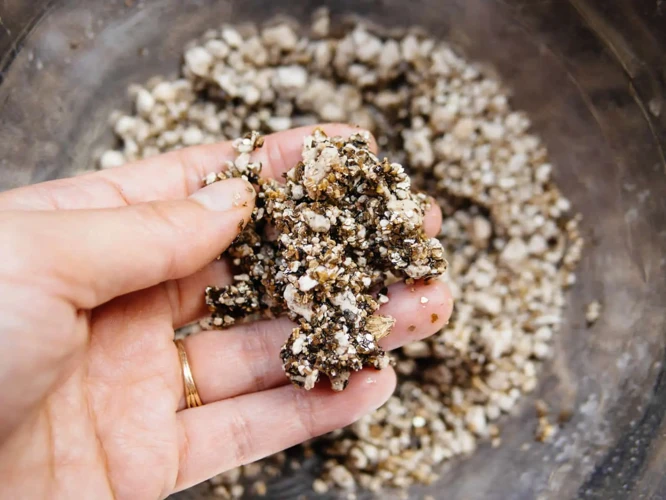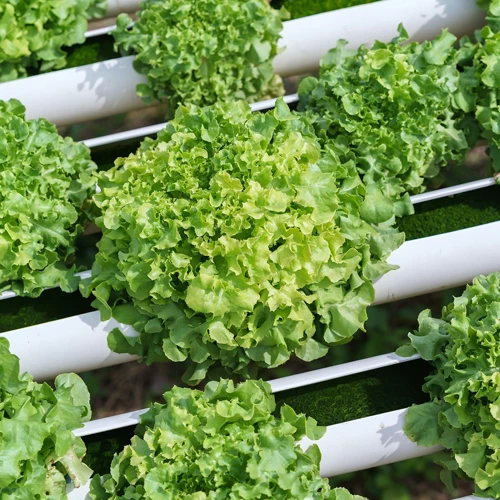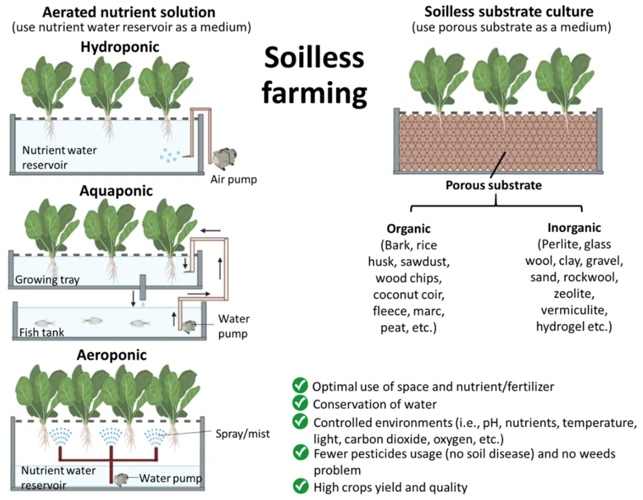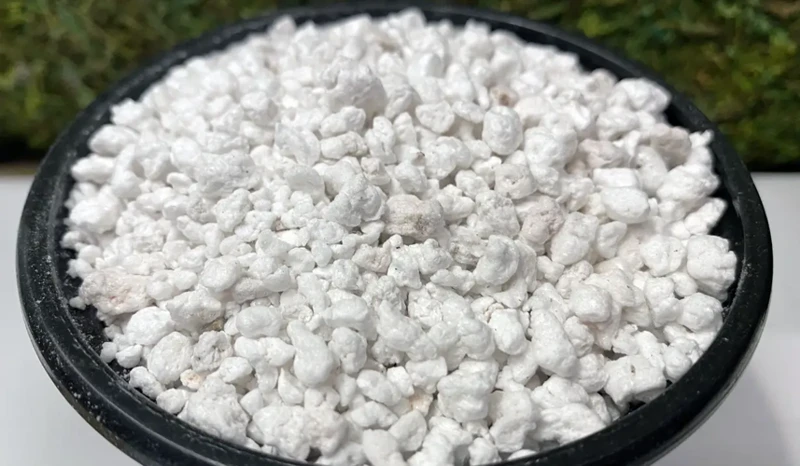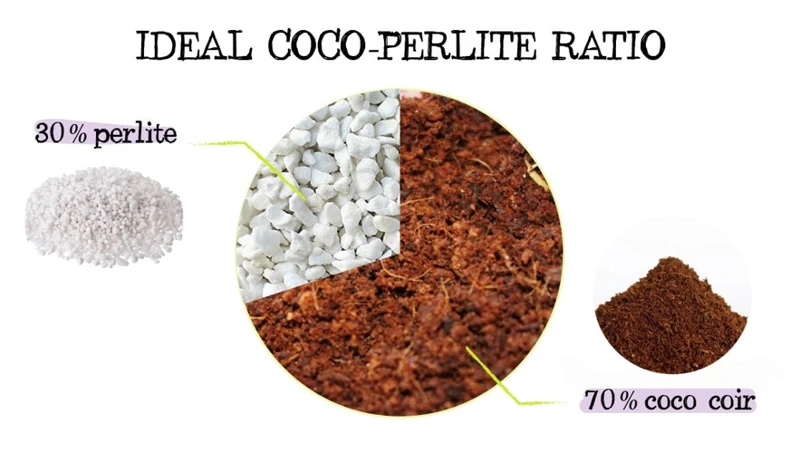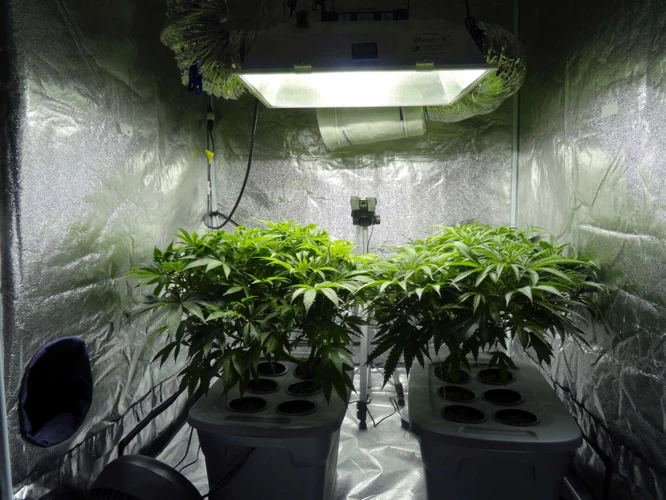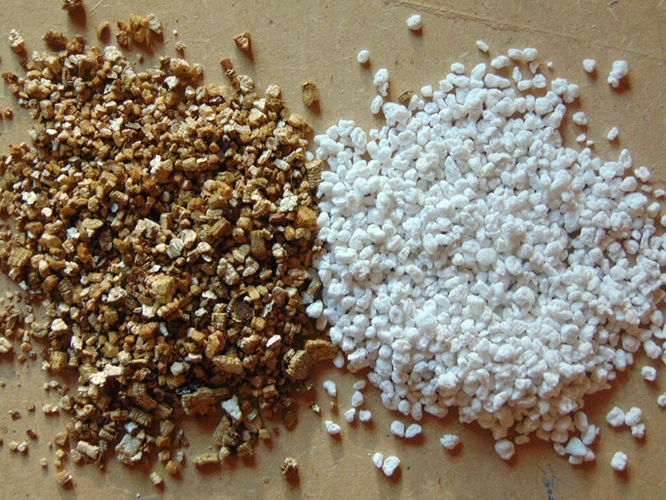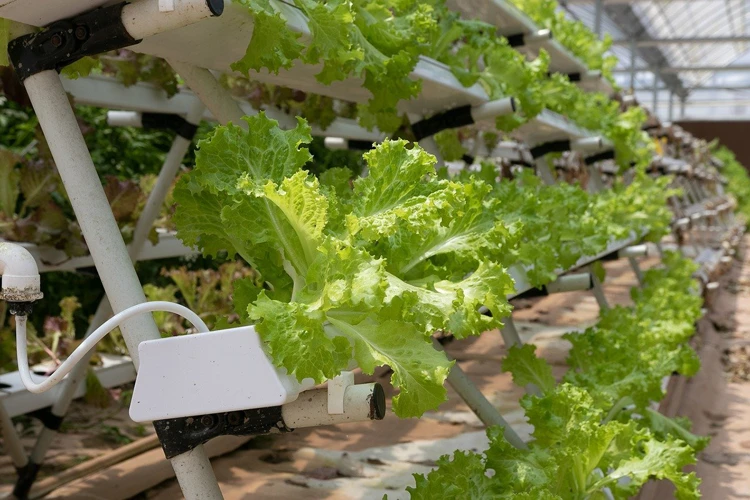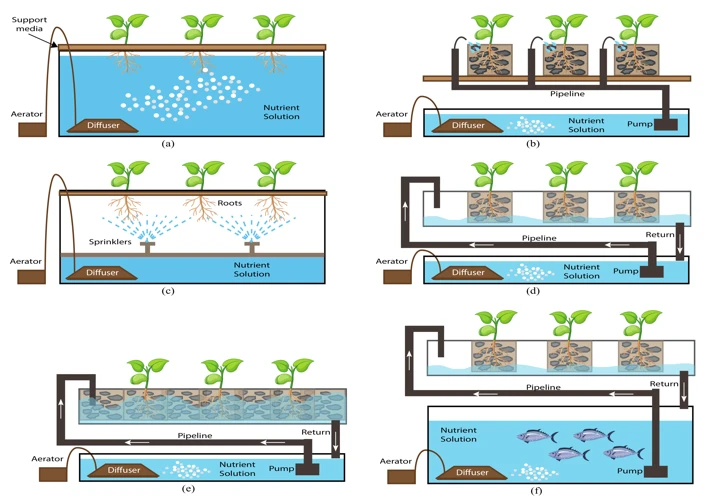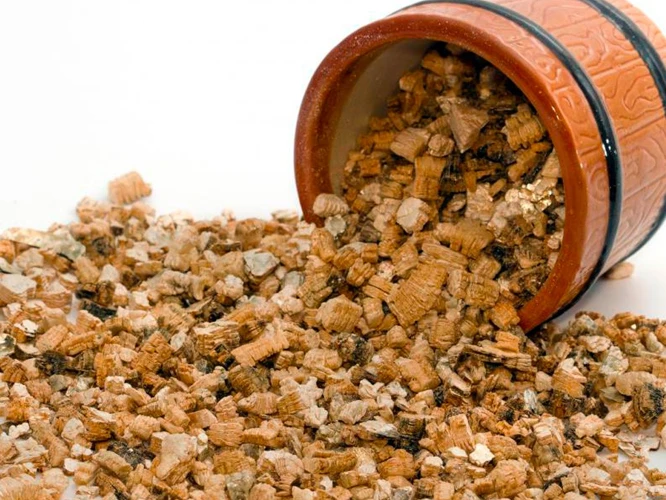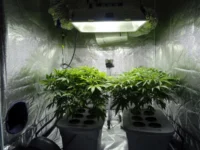
How to Enhance Your Cannabis Hydroponic System Using Perlite and Vermiculite
Hydroponic systems have been gaining popularity among cannabis growers for their ability to increase yield and improve quality. One important aspect of hydroponic cultivation is the growing medium, which must provide adequate support, moisture retention, and oxygenation for the plant’s roots. Two commonly used growing media in hydroponics are perlite and vermiculite, but many growers struggle with how to properly use them. In this comprehensive guide, we’ll explore everything you need to know about using perlite and vermiculite in hydroponic systems for cannabis cultivation. From their definition and advantages to preparation and maintenance, we’ll cover it all. Whether you’re a beginner or an experienced grower, this guide will help you make the most out of your hydroponic system.
What Are Perlite and Vermiculite?
Contents
If you’re new to hydroponic gardening, you may have come across the terms “perlite” and “vermiculite” and wondered what they are and how they can benefit your cannabis plants. Both are natural minerals commonly used in hydroponics as growing mediums to support root systems, and each has its unique characteristics that make it advantageous for certain types of growing setups. In this section of the article, we’ll explore in more detail what perlite and vermiculite are, how they differ from one another, and what makes them ideal for hydroponic cultivation.
Perlite
Perlite is a versatile and widely used medium in hydroponics. It is made from volcanic glass that has been heated to high temperatures. This heating process causes the glass to expand and form small white granules that are ideal for use in hydroponic systems.
Advantages of Perlite in Hydroponics
- Perlite is lightweight and does not compact, allowing for good drainage and aeration for plant roots.
- It is pH neutral, which means it does not affect the pH of the nutrient solution, allowing for accurate and consistent nutrient uptake.
- Perlite is sterile and free of pests and diseases, which helps to prevent the spread of any potential problems in the hydroponic system.
- It is easy to find and relatively inexpensive compared to other hydroponic growing mediums.
Preparing Perlite for use in Hydroponics
Before using perlite in hydroponics, it is important to prepare it properly to ensure it is clean and free of any debris or dust. The following steps can be taken to prepare perlite for use in hydroponic systems:
| Step | Description |
|---|---|
| 1 | Fill a bucket or container with perlite. |
| 2 | Immerse the perlite in water and stir it around to wash away any dust or debris. |
| 3 | Drain the water and repeat the washing process until the perlite is clean. |
| 4 | Allow the perlite to dry completely before using it in hydroponic systems. |
Mixing Perlite in Your Hydroponic System
Perlite can be mixed with other growing mediums, such as vermiculite or coconut coir, to create a well-rounded growing medium for your plants. The proportion of perlite to other mediums will depend on the specific needs of the plants being grown in the hydroponic system. Typically, a mix of 50% perlite and 50% other medium is a good starting point.
When mixing perlite in hydroponic systems, it is important to ensure that it is evenly distributed throughout the growing area. This can be done by gently mixing and spreading the perlite in the system.
Watering Cannabis Plants using Perlite
As perlite is a lightweight medium, it allows for good drainage and aeration, which is important for healthy root development. When watering cannabis plants grown in perlite, it is important to ensure that the growing medium is evenly moist, but not saturated. Overwatering can lead to root rot and other problems.
Maintaining Perlite in Your Hydroponic System
Perlite is a low-maintenance growing medium and does not require any special maintenance beyond regular monitoring of water levels and nutrient solutions. It is important to keep an eye on the pH levels of the nutrient solution, as perlite is pH neutral and can be affected by imbalanced pH levels.
Replacing Perlite in Your Hydroponic System
Perlite is a durable and long-lasting medium that can be reused for several growing cycles. However, over time it can become compacted and lose its ability to provide adequate drainage and aeration for plant roots. When this happens, it is time to replace the perlite in your hydroponic system.
Factors to Consider when using Perlite in Hydroponic Systems
When using perlite in hydroponic systems, it is important to consider several factors that can affect plant growth and development. These factors include temperature, humidity, lighting, and nutrient levels.
Common Mistakes to Avoid when using Perlite in Hydroponics
Some common mistakes to avoid when using perlite in hydroponic systems include overwatering, using perlite that has not been properly prepared, and failing to monitor pH levels in the nutrient solution.
Pros and Cons of using Perlite in Hydroponics
| Pros | Cons |
|---|---|
| Lightweight and provides good drainage and aeration for roots | May become compacted and lose effectiveness over time |
| PH neutral and free of pests and diseases | May require frequent replacement in hydroponic systems |
| Relatively inexpensive compared to other growing mediums | Requires proper preparation before use in hydroponic systems |
Safety and Health Concerns to Keep in Mind when using Perlite in Hydroponics
While perlite is generally considered safe for use in hydroponic systems, it can cause irritation if it comes into contact with the skin, eyes, or respiratory system. It is important to wear proper protective gear, such as gloves and a mask, when preparing and handling perlite.
Vermiculite
Vermiculite is another mineral that can be used in hydroponic systems for cannabis cultivation, providing numerous benefits for the plants’ growth and development. This natural mineral is formed by the weathering of a type of rock called biotite, and it has excellent water-retaining properties.
Advantages of Using Vermiculite in Hydroponics
One of the main advantages of using vermiculite in hydroponics is its high water-retention capacity. Vermiculite is capable of retaining water up to four times its weight, which makes it an excellent substrate for hydroponic systems that require a constant supply of moisture. Additionally, vermiculite has good drainage properties, which means that it can provide adequate aeration to the roots while allowing excess water to drain away.
Another benefit of using vermiculite in hydroponics is its ability to provide a stable pH level. Vermiculite has a pH level close to neutral, which makes it a suitable substrate for cannabis plants that prefer a slightly acidic to a neutral environment. Vermiculite can help buffer the pH of the nutrient solution, maintaining a healthy and stable environment for the roots.
How to Prepare Vermiculite for Use in Hydroponics
Before using vermiculite in a hydroponic system, it is essential to prepare it properly to remove any dust, debris, or foreign particles. The following steps can be followed to prepare vermiculite for use in hydroponics:
1. Pour the vermiculite into a clean bucket or container.
2. Rinse the vermiculite thoroughly with water to remove any dust or impurities. Use a fine mesh or colander to prevent the vermiculite from washing away.
3. Immerse the vermiculite in water for several hours to saturate it adequately.
4. Drain the excess water from the vermiculite and let it rest for a few hours to allow any surplus water to evaporate.
5. Repeat steps 3 and 4 until the vermiculite is evenly saturated and moist.
How to Mix Perlite and Vermiculite in Your Hydroponic System
Perlite and vermiculite can be mixed in various ratios according to the specific needs of the plants and the hydroponic system. A common ratio is 50% perlite and 50% vermiculite, which can provide excellent water retention, drainage, and aeration properties. Other ratios can be used depending on the plants’ stage of growth, environmental conditions, and nutrient requirements.
How to Water Your Cannabis Plant Using A Perlite and Vermiculite Mix
When watering cannabis plants grown in a perlite and vermiculite mix, it is essential to use a nutrient solution that is pH-balanced and adequately diluted. The water should be added slowly to allow it to penetrate the substrate evenly and prevent any waterlogging or pooling. The plants’ watering schedule should be adjusted according to their stage of growth, the environmental conditions, and the nutrient requirements.
How to Maintain Vermiculite in Your Hydroponic System
Vermiculite requires little maintenance in hydroponic systems, but it is important to monitor its moisture content and pH level regularly. Vermiculite can be refreshed periodically by adding new vermiculite and removing any old or depleted material. Vermiculite should be kept clean and free of debris, and any signs of mold or fungal growth should be addressed promptly.
When to Replace Vermiculite in Your Hydroponic System
Vermiculite can last for several growing cycles in a hydroponic system, depending on its quality, maintenance, and usage. However, it is recommended to replace vermiculite every six to eight months to ensure optimal performance and prevent any contamination or blockages in the system.
Factors to Consider When Using Vermiculite in Hydroponic Systems
Temperature and humidity levels should be monitored closely when using vermiculite in hydroponic systems. Vermiculite can absorb moisture from the air, which can affect its water-retention capacity and pH level. Additionally, vermiculite can become compacted over time, reducing its aeration and drainage properties, which can lead to root rot or suffocation. Proper ventilation and air circulation can help prevent these issues and ensure optimal plant growth.
Pros and Cons of Using Vermiculite in Hydroponics
Here is a summary of the pros and cons of using vermiculite in hydroponic systems:
Pros:
- High water-retention capacity
- Good drainage properties
- Stable pH level
- Easy to prepare and use
Cons:
- Can become compacted over time
- May absorb moisture from the air
- Requires periodic replacement
Safety and Health Concerns to Keep in Mind When Using Vermiculite
Vermiculite is generally considered safe to use in hydroponic systems, but it is important to wear gloves and a dust mask when handling or preparing it. Vermiculite can release dust particles that can irritate the eyes, nose, throat, and lungs if inhaled. Additionally, some vermiculite products may contain asbestos fibers, which can pose a health risk if ingested or inhaled. It is important to use vermiculite products that have been certified asbestos-free.
Conclusion
Vermiculite is a versatile substrate that can provide numerous benefits for cannabis growth and development in hydroponic systems. When used correctly and maintained properly, vermiculite can help create a stable and healthy environment for the roots, ensuring optimal plant growth and yield.
Advantages of Using Perlite and Vermiculite in Hydroponics
If you’re looking for a way to boost the health, growth and yield of your cannabis plants, using perlite and vermiculite in your hydroponic setup can confer a number of benefits. These lightweight, easy to use mediums help to improve water retention, aeration and nutrient delivery to the roots of your plants, which can result in more robust, healthy and productive cannabis crops. In this section, we’ll explore the unique advantages that perlite and vermiculite bring to hydroponic cultivation and how they can help you achieve better results.
Perlite
Perlite is a lightweight and porous material made from volcanic glass that has been heated and popped like popcorn. It is a common choice for hydroponic growers due to its excellent drainage properties and ability to hold oxygen between particles. Here are some of the benefits of using perlite in hydroponics:
| Advantages | Explanation |
| Improves drainage | Perlite particles are irregular in shape and create air pockets in the growing medium, allowing excess water to drain away freely. |
| Increases aeration | The porous nature of perlite allows air to circulate around plant roots, providing much-needed oxygen for healthy growth and preventing root rot. |
| Lightweight | Perlite is easy to handle due to its lightweight nature, making it a popular choice for hydroponic systems where large amounts of growing media are needed. |
| Neutral pH | Perlite is pH-neutral, meaning it won’t affect the pH of your nutrient solution. |
| Reusable | Perlite can be reused multiple times with proper sterilization, making it an economical and eco-friendly choice for hydroponic growers. |
To prepare perlite for use in hydroponic systems, it is important to first rinse it thoroughly to remove any dust or debris. This can be done by placing the perlite in a colander or mesh strainer and running water through it until it runs clear. After rinsing, perlite can be mixed with other growing media, such as vermiculite, in various ratios depending on the specific needs of the plants being grown. It is important to monitor the moisture level in perlite and adjust watering accordingly, as it can dry out more quickly than other growing media. In general, perlite should be replaced or sterilized after each use to prevent the build-up of bacteria or pathogens.
Vermiculite
Vermiculite is another popular hydroponic growing medium that has excellent water and nutrient holding capabilities. It is a naturally occurring mineral that is mined and processed into a lightweight material that is perfect for hydroponic gardening. Vermiculite is also pH neutral, which means that it won’t affect the acidity or alkalinity of your nutrient solution.
Advantages of Vermiculite in Hydroponics
One of the main advantages of using vermiculite in hydroponics is its ability to hold onto water and nutrients. Vermiculite has a very high cation exchange capacity (CEC), which means that it can hold onto positively charged ions like potassium, calcium, and magnesium, as well as important micronutrients like iron and manganese. This makes it an excellent medium for growing plants that require a lot of nutrients.
Another advantage of vermiculite is that it has excellent aeration properties, which helps to prevent root rot and other fungal diseases. The particles of vermiculite are porous and irregularly shaped, allowing for plenty of air pockets to form around the roots of your plants. This also allows for better drainage, which is important in hydroponic systems where overwatering can be a problem.
How to Prepare Vermiculite for Use in Hydroponics
To prepare vermiculite for use in hydroponics, you should first soak it in water for a couple of hours to remove any dust or debris. Then, you should rinse it thoroughly to remove any excess water and allow it to drain before placing it in your hydroponic system.
Mixing Perlite and Vermiculite
A common practice in hydroponic gardening is to mix vermiculite and perlite together in equal parts. This mixture provides a good balance of water retention, nutrient holding capacity, and aeration, making it an excellent medium for growing plants.
Maintaining Vermiculite in Your Hydroponic System
To maintain vermiculite in your hydroponic system, you should regularly check the pH level of your nutrient solution to ensure that it remains neutral. You should also monitor the moisture level of the vermiculite and adjust the watering schedule as needed. Additionally, you should be careful not to over-fertilize your plants, as vermiculite has a high CEC and can hold onto excess nutrients.
Replacing Vermiculite in Your Hydroponic System
Vermiculite should be replaced in your hydroponic system every 2-3 years, or when it begins to break down and lose its structure. You can tell when it’s time to replace your vermiculite by checking to see if it has become compressed or has lost its ability to hold water and nutrients.
Vermiculite is an excellent hydroponic growing medium that has many advantages, including good water retention, high nutrient holding capacity, and excellent aeration properties. By following the proper preparation and maintenance steps, you can ensure that your plants thrive in a vermiculite-based hydroponic system.
How to Prepare Perlite and Vermiculite for Use in Hydroponics
Before using perlite and vermiculite in your hydroponic system, it is important to properly prepare them for use. You want to ensure that they are clean and free of any contaminants that could negatively impact your cannabis plants. In this section, we will guide you through the step-by-step process of preparing perlite and vermiculite for use in hydroponics, highlighting important details to consider along the way. By the end of this section, you will have a thorough understanding of how to prepare a high-quality perlite and vermiculite mix for your hydroponic cannabis cultivation.
Perlite
Perlite is a commonly used hydroponic growing medium due to its numerous benefits. Here are some key things to keep in mind when using perlite in your hydroponic system:
Benefits of Perlite:
- Lightweight: Perlite is a lightweight mineral that allows for easy handling and maneuverability in a hydroponic system.
- Aerates the Soil: Perlite is a porous material that allows for adequate aeration of the soil, which is essential for healthy root growth and nutrient absorption.
- Retains Moisture: Perlite retains moisture and prevents water from being trapped in the soil, which can lead to overwatering and root rot.
- Provides Good Drainage: Perlite provides good drainage, which is necessary to ensure that the roots do not sit in standing water.
- Compatible with a Wide Range of Nutrient Solutions: Perlite is compatible with a wide range of nutrient solutions, making it a versatile choice for hydroponic growers.
Preparing Perlite:
When using perlite in a hydroponic system, it is important to sterilize it first to remove any impurities or pathogens that may harm your plants. To sterilize perlite, place it in a container and pour boiling water over it. Let it sit for a few hours before draining the water and rinsing the perlite thoroughly.
Mixing Perlite in Your Hydroponic System:
Mix perlite with your chosen nutrient solution in a ratio of approximately 50:50. The exact ratio may vary based on the specific needs of your plants and the type of hydroponic system you are using.
Maintaining Perlite:
To maintain perlite in your hydroponic system, it is important to monitor the pH level of the nutrient solution regularly. Perlite has a natural pH of around 7.0, so it is important to adjust the pH level of your nutrient solution accordingly. Additionally, perlite should be replaced every few years to ensure its effectiveness as a growing medium.
Perlite is an excellent choice for hydroponic growers due to its lightweight, aerating properties, moisture retention, and good drainage. It is easy to prepare and compatible with a wide range of nutrient solutions. Just remember to sterilize it before use and monitor the pH level of your nutrient solution regularly.
Vermiculite
Vermiculite is another popular growing medium used in hydroponic systems. It is a naturally occurring mineral that is formed when mica is heated rapidly. Vermiculite has a very high water holding capacity, which makes it a great choice for plants that require a lot of hydration.
Advantages of Using Vermiculite in Hydroponics:
| Advantages | Explanation |
| Water retention | Vermiculite can hold up to 3-4 times its weight in water, which means your plants will have access to ample hydration. |
| Nutrient retention | Not only does vermiculite hold water well, it also has a high cation exchange capacity (CEC), allowing it to also hold onto nutrients and release them to the plants as needed. |
| Aeration | Like perlite, vermiculite also helps to promote good air flow in your hydroponic system which is essential for plant growth and root development. |
How to Prepare Vermiculite for Use in Hydroponics:
To prepare vermiculite for use in hydroponics, begin by soaking it in water for several hours to remove any impurities or dust. After soaking, rinse it thoroughly with fresh water and allow it to drain completely.
How to Mix Vermiculite in Your Hydroponic System:
Vermiculite can be used on its own or mixed with other growing mediums such as perlite or coconut coir. When mixing vermiculite, you should aim for a ratio of 25-50% vermiculite to other growing mediums.
How to Water Your Cannabis Plant Using Vermiculite:
Watering your cannabis plants in a vermiculite mix is similar to watering with perlite. Allow the top inch of the growing medium to dry out before watering, and then water your plants thoroughly.
How to Maintain Vermiculite in Your Hydroponic System:
To maintain vermiculite in your hydroponic system, it’s important to regularly monitor the water levels and pH. Vermiculite can hold onto nutrients, so it’s important to ensure there is not an excess buildup that can lead to toxicity.
When to Replace Vermiculite in Your Hydroponic System:
Vermiculite has a long lifespan and can last for several years in your hydroponic system. However, if you notice that it has become compacted or is no longer holding onto water or nutrients effectively, it may be time to replace it.
Factors to Consider When Using Vermiculite in Hydroponic Systems:
Temperature and humidity levels should be considered when using vermiculite in hydroponic systems. Because vermiculite retains moisture well, high humidity levels can lead to over-saturation of the growing medium.
In terms of lighting and nutrients, vermiculite is an excellent choice for plants that require a lot of hydration but do not need excessive amounts of nutrients.
Pros and Cons of Using Vermiculite in Hydroponics:
| Pros | Cons |
| Excellent water retention | Can become compacted and prevent good air flow in your hydroponic system. |
| High cation exchange capacity | Can lead to over-saturation if humidity levels are too high. |
| Long lifespan |
Safety and Health Concerns to Keep in Mind When Using Vermiculite:
While vermiculite itself is safe, there have been concerns about asbestos contamination in some vermiculite products. It’s important to purchase vermiculite from a reputable source and to avoid those labeled as potentially containing asbestos. Additionally, respiratory protection should be worn when handling vermiculite dust.
How to Mix Perlite and Vermiculite in Your Hydroponic System
Mixing perlite and vermiculite in your hydroponic system is a relatively simple process that can be done in a few steps. The resulting mix will provide excellent drainage, good aeration, and water retention, creating an optimal environment for your cannabis plants to grow healthily.
Step 1: Gather Necessary Materials
Before mixing the perlite and vermiculite, it’s important to make sure you have all the necessary materials. You will need:
– Perlite
– Vermiculite
– A clean container to mix them in
– A measuring cup or scoop
Step 2: Determine Ratio
The next step is to decide on the ratio of perlite and vermiculite you want to use. A common ratio to start with is a 50/50 mix of perlite and vermiculite. However, some growers prefer to use more perlite and less vermiculite or vice versa, depending on the specific needs of their plants.
Step 3: Measure Out the Perlite and Vermiculite
Using your measuring cup or scoop, measure the desired amount of perlite and vermiculite into your mixing container. An easy way to start is with equal amounts of perlite and vermiculite.
Step 4: Mix the Perlite and Vermiculite
Once you have measured out the desired amounts of perlite and vermiculite, it’s time to mix them thoroughly. Use your hands or a trowel to mix the two substrates together. Make sure the perlite and vermiculite are evenly distributed throughout the mixture.
Step 5: Add Mixture to Your Hydroponic System
Now that your perlite and vermiculite are mixed, it’s time to add the mixture to your hydroponic system. Spread the mixture evenly throughout the basin, making sure there are no large clumps or areas where the mixture is more concentrated.
Step 6: Water the Mix to Settle it in the System
Once you have added the perlite and vermiculite mix to your hydroponic system, water it thoroughly to help settle the mixture in place. This will also help hydrate the substrates and prepare them for planting.
Mixing perlite and vermiculite in your hydroponic system is an easy process that can provide significant benefits for your cannabis plants. Make sure to measure out the desired ratio of perlite and vermiculite, mix them thoroughly, and evenly spread the mixture throughout your system. Don’t forget to water the mixture to help settle it into place and prepare it for planting.
How to Water Your Cannabis Plant Using A Perlite and Vermiculite Mix
When using a perlite and vermiculite mix in your hydroponic system, it’s important to water your cannabis plant properly to ensure optimal growth and health. The perlite and vermiculite mix provides excellent aeration and drainage for your plant’s roots, but it also means that you’ll need to water your plant a bit differently than you would in soil.
Step 1: Check the Moisture Level
Before watering your plant, it’s essential to check the moisture level of the mix to avoid over or under-watering. Insert your finger about an inch deep into the mix to feel the moisture level. If it feels dry, it’s time to water your plant.
Step 2: Water Your Plant
It’s essential to water your plant slowly and evenly to avoid drowning the roots. Use a watering can or a drip system to avoid disturbing the perlite and vermiculite mix. Allow the water to flow through the mix, and make sure to saturate the root zone thoroughly.
Step 3: Drain the Excess Water
After watering, don’t forget to allow the excess water to drain out of the bottom of your container. Make sure to empty your drainage tray to avoid waterlogged roots, which can lead to problems such as rot and pests.
Step 4: Monitor Your Plant
After watering, keep an eye on your plant to ensure it’s not showing signs of over or under-watering. Over-watering can cause the roots to suffocate, while under-watering can stunt growth and cause wilting. Check your plant daily and make adjustments to your watering schedule as needed.
Step 5: Adjust pH and Nutrient Levels
Using perlite and vermiculite mix can affect the pH and nutrient levels of your hydroponic system. Test your water for pH and nutrient levels regularly to ensure they’re within the optimal range for cannabis growth. Adjust the pH and nutrient levels as needed to promote healthy growth.
Watering your cannabis plant using a perlite and vermiculite mix requires some extra attention to ensure optimal growth and health. However, with proper care, your cannabis plants can thrive in a hydroponic system using perlite and vermiculite.
How to Maintain Perlite and Vermiculite in Your Hydroponic System
Keeping perlite and vermiculite in your hydroponic system well-maintained is crucial for the success of your cannabis cultivation. Here are the steps to follow:
1. Regularly check the pH level: Perlite and vermiculite can change the pH level of your hydroponic solution over time. It’s important to regularly test and adjust the pH level to keep it within the optimal range for cannabis cultivation, which is usually between 5.5 and 6.5.
2. Ensure proper drainage: Perlite and vermiculite both have excellent drainage properties, but it’s important to ensure that excess water is able to drain away and not collect around the roots of your cannabis plants. Make sure your hydroponic system has adequate drainage holes and that the water level is not too high.
3. Monitor for pests and diseases: Perlite and vermiculite are inert materials and do not contain any nutrients, but they can still harbor pests and diseases that can harm your cannabis plants. Regularly inspect the perlite and vermiculite for any signs of pests or diseases and take appropriate measures to eliminate them.
4. Replace as needed: Over time, perlite and vermiculite can break down and become compacted, reducing their ability to provide adequate drainage and aeration to your cannabis plants. Monitor your perlite and vermiculite, and replace them as needed to ensure optimal growth conditions for your plants.
5. Clean and sanitize: Before reusing perlite and vermiculite, make sure to clean and sanitize them to remove any potential pests or diseases. You can rinse them with a solution of hydrogen peroxide and water or a weak bleach solution, then rinse thoroughly with water before adding them back into your hydroponic system.
By following these maintenance steps, you can ensure that your perlite and vermiculite remain in excellent condition and provide the best growing environment for your cannabis plants.
When to Replace Perlite and Vermiculite in Your Hydroponic System
Over time, perlite and vermiculite in your hydroponic system will break down and become less effective at providing the necessary aeration and water retention for your cannabis plants. As a result, it is important to know when and how to replace them.
Visual Inspection
One way to determine if it is time to replace your perlite and vermiculite is through a visual inspection. If you notice that the perlite and vermiculite are compacted, discolored, or have a foul odor, it may be a sign that they need to be replaced. Additionally, if the perlite and vermiculite particles have broken down to the point where they are no longer visible, it is a strong indication that they are no longer providing the necessary aeration and water retention.
pH Testing
Another way to determine if it is time to replace your perlite and vermiculite is through pH testing. As perlite and vermiculite break down, they can alter the pH of the nutrient solution and the root zone. A sudden and sustained drop in pH can be a sign that the perlite and vermiculite need to be replaced.
Replacing Perlite and Vermiculite
When it comes time to replace your perlite and vermiculite, it is important to remove as much of the old substrate as possible. This can be done by flushing the root zone with water or by removing the plants and manually removing the perlite and vermiculite. Once the old substrate has been removed, it is important to thoroughly clean and disinfect the hydroponic system to prevent any pathogens from contaminating the new substrate.
Frequency of Replacement
The frequency at which you need to replace your perlite and vermiculite will depend on a number of factors, such as the size of your hydroponic system, the size of your plants, and the type of nutrient solution you are using. As a general rule, perlite and vermiculite should be replaced every 1 to 2 years, but it is important to monitor the health of your plants and the condition of the substrate to determine when replacement is necessary.
Factors to Consider When Using Perlite and Vermiculite in Hydroponic Systems
When using perlite and vermiculite in your hydroponic system for cannabis cultivation, there are several factors that you need to consider. These factors play a critical role in ensuring that your cannabis plants thrive and produce a high yield. From temperature and humidity to lighting and nutrients, each factor presents its own unique challenges that require careful planning and attention. In this section, we’ll explore the different factors you need to consider when using perlite and vermiculite in hydroponics and how to overcome any challenges that may arise. So let’s dive in!
Temperature and Humidity
When using perlite and vermiculite in hydroponic systems for cannabis cultivation, it is important to consider the effects of temperature and humidity on the performance of the plants.
Temperature: Cannabis plants thrive in temperatures between 68-77℉ (20-25℃) during the day and 59-68℉ (15-20℃) during the night. In order to maintain a consistent temperature, it is recommended to use a thermometer to monitor the temperature in the grow area. If the temperature becomes too high, the plants may become stressed and wilt. On the other hand, if the temperature is too low, the plants may not grow properly.
Humidity: Cannabis plants also require a specific range of humidity levels in order to grow properly. During the vegetative stage, humidity levels should be between 50-70%. During the flowering stage, humidity levels should be reduced to 40-50%. It is important to monitor the humidity levels using a hygrometer to avoid problems such as mold or mildew on the plants. Perlite and vermiculite can help regulate humidity levels in the grow area by absorbing and releasing moisture as needed.
| Temperature | Humidity |
|---|---|
| Cannabis plants prefer temperatures between 68-77℉ (20-25℃) during the day and 59-68℉ (15-20℃) during the night. | During the vegetative stage, humidity levels should be between 50-70%. During the flowering stage, humidity levels should be reduced to 40-50%. |
| To maintain consistent temperature, use a thermometer to monitor grow area. | Use a hygrometer to monitor humidity levels in the grow area and avoid problems such as mold or mildew on the plants. |
| If temperature is too high, plants may become stressed and wilt. | Perlite and vermiculite can help regulate humidity levels in the grow area by absorbing and releasing moisture as needed. |
| If temperature is too low, plants may not grow properly. |
It is important to maintain proper temperature and humidity levels in the grow area to ensure healthy and productive cannabis plants. Using a mixture of perlite and vermiculite can also help regulate humidity levels and promote optimal growing conditions.
Lighting and Nutrients
Proper lighting and nutrient solution play a crucial role in the growth and development of cannabis plants in hydroponic systems. Here are some important points to keep in mind when it comes to lighting and nutrients:
- Light intensity: Cannabis plants require a specific amount of light intensity for optimal growth. Insufficient light can cause the plants to stretch and become weak. On the other hand, too much light can be harmful to the plants, causing them to burn or dry up. You need to provide appropriate lighting to ensure that the plants receive the right amount of intensity for healthy growth.
- Light duration: In addition to light intensity, the duration of light exposure also plays a crucial role in the growth of the plants. Cannabis plants require a specific amount of light and dark time to simulate their natural growth cycle. Generally, you should aim for a light/dark cycle of 18/6 or 24/0 during the vegetative stage and 12/12 light/dark cycle during the flowering stage.
- Nutrient solution: Hydroponic systems rely on nutrient solutions to provide essential minerals and nutrients to the plants. It’s important to maintain the correct pH and nutrient levels in the solution for optimal growth. You can monitor the pH and nutrient levels using a digital meter and adjust them accordingly. Be cautious not to overfeed or underfeed the plants, as both can lead to problems like nutrient burn or deficiencies.
- Nutrient ratios: The ratio of nutrients provided to the plants can also have a significant impact on their growth. During the vegetative stage, plants require higher levels of nitrogen, while during the flowering stage, they require more phosphorus and potassium. You can use specialized nutrient formulas designed for each stage for optimal results.
By paying attention to these important factors, you’ll be able to provide your cannabis plants with the optimal lighting and nutrients that they need to thrive in a hydroponic system.
Common Mistakes to Avoid When Using Perlite and Vermiculite in Hydroponics
When using perlite and vermiculite in hydroponic systems, it is important to avoid certain common mistakes to ensure optimal growth and health of your cannabis plants. These mistakes include:
1. Overwatering: Perlite and vermiculite are both great at retaining water and can easily become waterlogged if overwatered. This can lead to root rot and other issues. It is important to water your plants only when necessary, based on their individual needs and the environmental conditions of your setup.
2. Underwatering: While overwatering can be a problem, underwatering can be just as detrimental to the health of your plants. It is important to keep an eye on moisture levels and ensure your plants are getting enough water to thrive.
3. Not aerating the growing medium: Perlite and vermiculite are both excellent at retaining moisture, but this can also lead to a lack of oxygen around the roots. It is important to aerate the growing medium regularly, allowing fresh air circulation to ensure proper root function and growth.
4. Using low-quality perlite or vermiculite: Not all perlite and vermiculite are created equally, and using low-quality products can lead to poor results. It is important to choose high-quality, sterile perlite and vermiculite to ensure your plants are getting the best possible growing conditions.
5. Not adjusting nutrient levels: Perlite and vermiculite do not provide any nutrients to your plants and are used primarily as growing mediums. It is important to adjust nutrient levels in your hydroponic system to ensure your plants are getting the proper nutrition they need to thrive.
6. Not monitoring pH levels: pH levels in hydroponic systems can shift quickly and have a direct impact on plant health and growth. It is important to regularly monitor and adjust the pH levels to ensure your plants are getting the right balance of nutrients.
By avoiding these common mistakes, you can ensure that your cannabis plants grow strong and healthy in your hydroponic system using perlite and vermiculite as a growing medium.
Pros and Cons of Using Perlite and Vermiculite in Hydroponics
When considering the use of any growing medium in hydroponics, it is important to understand its advantages and disadvantages. Perlite and vermiculite are two popular choices for hydroponic systems. Each of these mediums has unique properties that can impact plant growth and overall system performance. In this section, we will examine the pros and cons of using perlite and vermiculite in hydroponics. By understanding these factors, you can make an informed decision about whether these materials are right for your cannabis cultivation needs.
Perlite
Perlite is a popular hydroponic growing medium that has many advantages. It is a type of volcanic glass that is heated to high temperatures, causing it to expand and become lightweight. Here are some key features of perlite in hydroponics:
- Highly porous: Perlite is highly porous, meaning it can hold a lot of air and water in its cavities. This helps ensure that your plants’ roots have access to both water and oxygen, which is essential for healthy growth.
- pH Neutral: Perlite is pH neutral, meaning it won’t affect the pH of your nutrient solution. This makes it easy to use in hydroponic systems where maintaining a stable pH is important.
- Lightweight: Perlite is a lightweight material, making it easy to handle and mix with other growing media. It also allows for good air circulation around your plant’s roots.
- Reusable: Perlite can be reused multiple times, making it an economical choice for hydroponic growers. Simply sterilize it between uses to avoid the spread of disease.
- Insulating: Perlite acts as an insulator, helping to keep your nutrient solution at a stable temperature. This is especially useful in hydroponic systems that are exposed to fluctuating ambient temperatures.
Perlite is an excellent choice for hydroponic growers who want a lightweight, porous, and pH-neutral growing medium that can be reused multiple times. By using perlite in your hydroponic system, you can help ensure that your plants have access to the oxygen and water they need to thrive, while also maintaining a stable pH and temperature.
Vermiculite
Vermiculite is a natural mineral that is formed by the weathering of phyllosillicate minerals such as mica and has excellent water retention properties. The vermiculite particles appear like small, flat sheets that are arranged in a way that creates air pockets between them. Here are some key points to keep in mind when using vermiculite in hydroponics:
- Water Retention: Vermiculite is an excellent water retainer, as it can hold up to 3-4 times its weight in water. This makes it an ideal medium for hydroponic systems, where plants require a continuous supply of water and nutrients.
- Nutrient Retention: Vermiculite also has the ability to hold onto nutrients and release them slowly over time, ensuring that plants have a consistent supply of nutrients without the risk of over-fertilization.
- pH Neutral: Vermiculite has a neutral pH level, which means it will not alter the pH of your hydroponic system. This is important because maintaining the correct pH range is crucial for healthy plant growth.
- Lightweight: Vermiculite is a lightweight medium, making it easy to handle and transport. It also provides good aeration for plant roots.
- Non-toxic: Vermiculite is a safe and non-toxic medium that does not contain any harmful chemicals, making it ideal for growing cannabis and other plants for consumption.
When using vermiculite in hydroponics, it’s important to note that it can become compacted over time, reducing its water retention and aeration properties. It’s recommended to mix vermiculite with other mediums such as perlite to improve drainage and prevent compaction. Additionally, avoid using vermiculite in deep water culture systems as it can absorb too much water and drown the plant. Keeping these factors in mind, vermiculite can be an excellent addition to your hydroponic system, providing your plants with the essential water, nutrients, and oxygen they need for healthy growth.
Safety and Health Concerns to Keep in Mind When Using Perlite and Vermiculite
Safety and Health Concerns to Keep in Mind When Using Perlite and Vermiculite
Although perlite and vermiculite are generally safe to use in hydroponic systems, it’s important to be aware of potential health and safety concerns.
One of the main concerns with perlite is the dust it can create when handling or mixing it. Breathing in perlite dust can irritate your lungs and throat, leading to coughing and wheezing. To avoid inhaling perlite dust, it’s recommended to wear a dust mask when handling it.
Vermiculite can also pose a potential health risk if it contains asbestos. Asbestos was once commonly used in vermiculite products, but it’s now banned in many countries due to the serious health risks associated with inhaling asbestos fibers. If you’re unsure whether your vermiculite contains asbestos, it’s best to err on the side of caution and avoid using it.
Additionally, both perlite and vermiculite can be flammable, so it’s important to keep them away from open flames or heat sources.
When using perlite and vermiculite in your hydroponic system, it’s important to handle them with care and take necessary precautions to avoid any potential health and safety risks.
Conclusion
In conclusion, after learning about perlite and vermiculite and their advantages in a hydroponic system, it is clear that they can greatly benefit cannabis cultivation. Perlite and vermiculite are both lightweight, sterile, and porous, making them ideal for aeration, water retention, and nutrient delivery in hydroponics.
It is important to properly prepare and mix the perlite and vermiculite before using them in a hydroponic system. This involves soaking and rinsing them to remove any impurities or dust. It is also essential to maintain proper temperature and humidity levels in the grow environment and to use proper lighting and nutrients.
While there may be some common mistakes to avoid, the pros of using perlite and vermiculite in hydroponics outweigh the cons, as they can significantly increase yields and plant health. However, it is important to keep in mind the safety and health concerns associated with handling perlite and vermiculite, such as wearing protective gear and avoiding inhalation of dust particles.
Overall, using perlite and vermiculite in hydroponic systems can be a game-changer for cannabis cultivation, and by following the proper steps and precautions, growers can experience impressive results.
Frequently Asked Questions
What type of hydroponic systems can perlite and vermiculite be used in?
Perlite and vermiculite can be used in a variety of hydroponic systems including deep water culture, ebb and flow, and drip systems.
How do I prepare perlite for use in hydroponics?
To prepare perlite for use in hydroponics, you should rinse it thoroughly with water to remove any dust or debris.
What are the advantages of using vermiculite in hydroponics?
Vermiculite can hold moisture well and provide good aeration for plant roots, making it a good choice for hydroponic systems.
What should I do if I notice mold or bacteria growth on my perlite or vermiculite?
If you notice mold or bacteria growth, you should replace the affected perlite or vermiculite as soon as possible to prevent any harm to your plants.
Can I mix perlite and vermiculite together in my hydroponic system?
Yes, you can mix perlite and vermiculite together in your hydroponic system. This can provide a balanced mix of moisture and aeration.
How often should I water my plants when using perlite and vermiculite in hydroponics?
The frequency of watering will depend on the specific plants and system you are using, but generally you should water when the top layer of the mix feels dry to the touch.
Is it necessary to replace perlite and vermiculite in my hydroponic system?
Yes, over time perlite and vermiculite can break down and lose their effectiveness, so it is necessary to replace them periodically.
Can I reuse old perlite and vermiculite?
You can reuse old perlite and vermiculite, but it is recommended to sterilize them first to prevent any potential contamination.
Can using perlite and vermiculite in hydroponics affect the flavor of my cannabis plants?
No, perlite and vermiculite do not affect the flavor of cannabis plants.
Are there any health risks associated with using perlite and vermiculite in hydroponics?
There may be some dust generated during preparation and use of perlite and vermiculite, so wearing a mask is recommended to prevent inhalation of any harmful particles.

